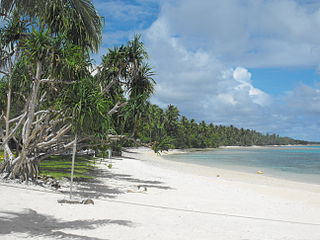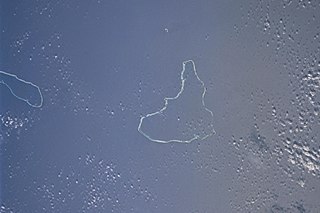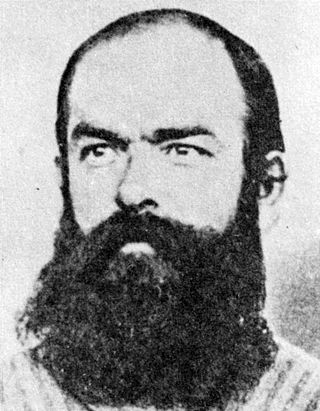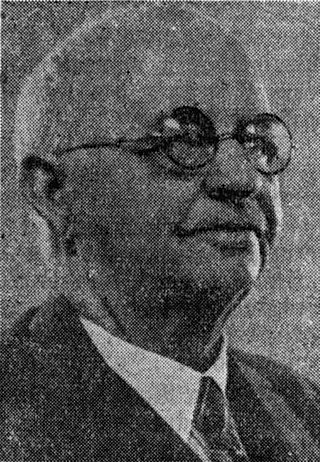
The Marshall Islands, officially the Republic of the Marshall Islands, is an island country west of the International Date Line and north of the equator in the Micronesia region in the Northwestern Pacific Ocean. The territory consists of 29 coral atolls and five islands, divided across two island chains: Ratak in the east and Ralik in the west. 97.87% of its territory is water, the largest proportion of water to land of any sovereign state. The country shares maritime boundaries with Wake Island to the north, Kiribati to the southeast, Nauru to the south, and the Federated States of Micronesia to the west. The capital and largest city is Majuro, home to approximately half of the country's population.
Austronesian settlers arrived in the Marshall Islands in the 2nd millennium BC, but there are no historical or oral records of that period. Over time, the Marshallese people learned to navigate over long ocean distances by walap canoe using traditional stick charts.

Majuro is the capital and largest city of the Marshall Islands. It is also a large coral atoll of 64 islands in the Pacific Ocean. It forms a legislative district of the Ratak (Sunrise) Chain of the Marshall Islands. The atoll has a land area of 9.7 square kilometers (3.7 sq mi) and encloses a lagoon of 295 square kilometers (114 sq mi). As with other atolls in the Marshall Islands, Majuro consists of narrow land masses. It has a tropical trade wind climate, with an average temperature of 27 °C (81 °F).

German Samoa was a German protectorate from 1900 to 1920, consisting of the islands of Upolu, Savai'i, Apolima and Manono, now wholly within the Independent State of Samoa, formerly Western Samoa. Samoa was the last German colonial acquisition in the Pacific basin, received following the Tripartite Convention signed at Washington on 2 December 1899 with ratifications exchanged on 16 February 1900. It was the only German colony in the Pacific, aside from the Jiaozhou Bay Leased Territory in China, that was administered separately from German New Guinea.

German New Guinea consisted of the northeastern part of the island of New Guinea and several nearby island groups and was the first part of the German colonial empire. The mainland part of the territory, called Kaiser-Wilhelmsland, became a German protectorate in 1884. Other island groups were added subsequently. The Bismarck Archipelago, and the North Solomon Islands were declared a German protectorate in 1885. The Caroline Islands, Palau, and the Mariana Islands were bought from Spain in 1899. German New Guinea annexed the formerly separate German Protectorate of Marshall Islands, which also included Nauru, in 1906. German Samoa, though part of the German colonial empire, was not part of German New Guinea.

Ailinglaplap or Ailinglapalap is a coral atoll of 56 islands in the Pacific Ocean, and forms a legislative district of the Ralik Chain in the Marshall Islands. It is located 152 kilometres (94 mi) northwest of Jaluit Atoll. Its total land area is only 14.7 square kilometers (5.7 sq mi), but it encloses a lagoon of 750 square kilometers (290 sq mi). The economy of the atoll is dominated by coconut plantations. The population of the atoll was 1,175 in 2021. Jabat Island is located off the coast of Ailinglaplap Atoll. The former president of the Marshall Islands, Kessai Note, was born on Jeh Island, Ailinglaplap Atoll.

Kaiser-Wilhelmsland formed part of German New Guinea, the South Pacific protectorate of the German Empire. Named in honour of Wilhelm I, who reigned as German Emperor from 1871 to 1888, it included the northern part of present-day Papua New Guinea. From 1884 until 1920 the territory was a protectorate of the German Empire. Kaiser-Wilhelmsland, the Bismarck Archipelago, the northern Solomon Islands, the Caroline Islands, Palau, Nauru, the Northern Mariana Islands, and the Marshall Islands comprised German New Guinea.

The German New Guinea Company was a German Chartered Company which exploited insular territory in and near present Papua New Guinea.

Morobe Province is a province on the northern coast of Papua New Guinea. The provincial capital and largest city is Lae. The province covers 33,705 km2, with a population of 674,810, and since the division of Southern Highlands Province in May 2012 it is the most populous province. It includes the Huon Peninsula, the Markham River, and delta, and coastal territories along the Huon Gulf. The province has nine administrative districts. At least 101 languages are spoken, including Kâte and Yabem language. English and Tok Pisin are common languages in the urban areas, and in some areas pidgin forms of German are mixed with the native language.

Rambutyo Island is one of the Admiralty Islands in the Bismarck Archipelago. Politically, Rambutyo Island is part of Manus Province, Papua New Guinea. The population (unknown) is concentrated on the west coast. Villages include Mouklen and Lengkau.

John Stanislaw Kubary also stated as Jan Stanisław Kubary, Jan Kubary, or Johann Stanislaus Kubary, was a Polish naturalist and ethnographer.

Georg Christian Thilenius was a German physician and anthropologist who was a native of Soden am Taunus.

Johann Cesar Godeffroy was a German trader, blackbirder and Hanseat.
Alfred Restieaux (1832–1911) was born in Paris, France, and came from a family of French descent. His grandfather was a French nobleman who escaped the guillotine during the French Revolution. At the age of 16 he migrated to Australia and later he travelled to South America and North America. He later became an island trader in the central Pacific. From 1867 to 1872 he had dealings with Ben Pease and Bully Hayes, two of the more notorious captains of ships and blackbirders that operated in the Pacific at that time.

Iserbrook was a general cargo and passenger brig built in 1853 at Hamburg (Germany) for Joh. Ces. Godeffroy & Sohn. It spent over twenty years as an immigrant and general cargo vessel, transporting passengers from Hamburg to South Africa, Australia and Chile, as well as servicing its owner's business in the Pacific. Later on, the vessel came into Australian possession and continued sailing for the Pacific trade. In 1878 it caught fire and was sunk the same year. At last, it was re-floated and used as a transport barge and hulk in Sydney until it sank again and finally was blown up.

Kabua the Great, also Kabua Laplap, was a Marshallese iroij whom the German Empire recognized as the king of the Marshall Islands. From 1863 until his death in 1910, he claimed to be the paramount chief, or iroijlaplap, of the Ralik Chain, though his cousin Loiak also claimed the title. Kabua worked with western missionaries and copra traders to expand his wealth and political power. He was also one of the several Marshallese iroij to sign treaties with the German Empire, first granting Germans exclusive trading rights in the Marshalls in 1878 and then legitimizing German annexation of the islands as a protectorate in 1885. The German treaties recognized Kabua as King of the Marshall Islands, though the German anthropologist Augustin Krämer noted that "Kabua is king only by the grace of the Germans."

As the township of Lae, in Morobe Province, Papua New Guinea is a relatively new entity, the history of the Lae environs is much older.
The Carolines Question was a conflict between the German Empire and the Kingdom of Spain over the sovereignty of the Caroline Islands and Palau in the western Pacific. It took place in 1885, at the beginning of the German colonial empire and towards the end of the Spanish Empire.

Maximilian Franz Thiel, often just called Max Thiel, was a German agent who worked for Hernsheim & Co in German New Guinea. He was manager of the Pacific operations of the German enterprise. His mother Rosetta Albertina was sister to Eduard and Franz Hernsheim, the founders of Hernsheim & Co. In at least 1884 he was living on Jaluit, Marshall Islands, at the same time as Franz Hernsheim. The year after he got to German New Guinea where he lived in Matupi in Rabaul, Niu Briten, Bismarck Archipelago where also Eduard Hernsheim lived. Here he was manager as well as part-time owner of Hernsheim & Co. During this time he was also Norwegian consul in German New Guinea.

Eugen Brandeis was a German merchant and engineer in Central America and an administrative official in the German colonies in the Pacific Ocean.

















